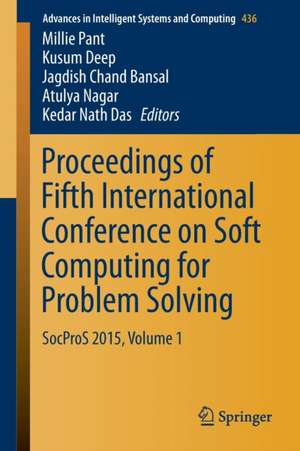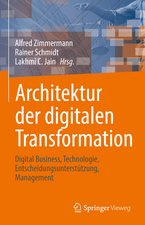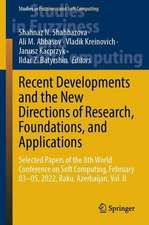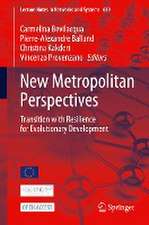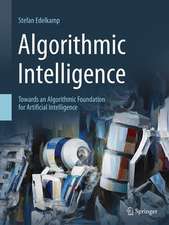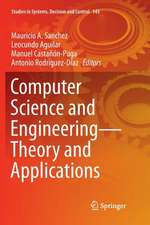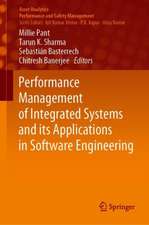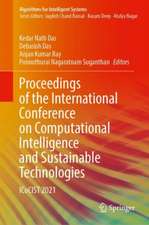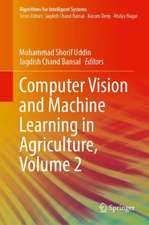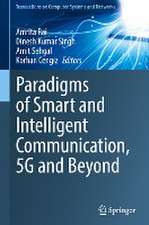Proceedings of Fifth International Conference on Soft Computing for Problem Solving: SocProS 2015, Volume 1: Advances in Intelligent Systems and Computing, cartea 436
Editat de Millie Pant, Kusum Deep, Jagdish Chand Bansal, Atulya Nagar, Kedar Nath Dasen Limba Engleză Paperback – 20 mar 2016
The different application areas covered in the proceedings are: ImageProcessing, Cryptanalysis, Industrial Optimization, Supply Chain Management,Newly Proposed Nature Inspired Algorithms, Signal Processing, Problems relatedto Medical and Health Care, Networking Optimization Problems, etc.
| Toate formatele și edițiile | Preț | Express |
|---|---|---|
| Paperback (2) | 1309.57 lei 43-57 zile | |
| Springer Nature Singapore – 21 apr 2016 | 1309.57 lei 43-57 zile | |
| Springer Nature Singapore – 20 mar 2016 | 1310.36 lei 43-57 zile |
Din seria Advances in Intelligent Systems and Computing
- 20%
 Preț: 1120.90 lei
Preț: 1120.90 lei - 20%
 Preț: 1090.59 lei
Preț: 1090.59 lei - 20%
 Preț: 1324.07 lei
Preț: 1324.07 lei - 20%
 Preț: 1989.79 lei
Preț: 1989.79 lei - 20%
 Preț: 1946.92 lei
Preț: 1946.92 lei - 18%
 Preț: 1273.28 lei
Preț: 1273.28 lei - 20%
 Preț: 2264.51 lei
Preț: 2264.51 lei - 20%
 Preț: 1337.27 lei
Preț: 1337.27 lei - 20%
 Preț: 1297.67 lei
Preț: 1297.67 lei - 20%
 Preț: 1315.82 lei
Preț: 1315.82 lei - 20%
 Preț: 1310.88 lei
Preț: 1310.88 lei - 20%
 Preț: 1302.62 lei
Preț: 1302.62 lei - 20%
 Preț: 882.20 lei
Preț: 882.20 lei - 20%
 Preț: 1305.93 lei
Preț: 1305.93 lei - 20%
 Preț: 1629.32 lei
Preț: 1629.32 lei - 20%
 Preț: 1345.49 lei
Preț: 1345.49 lei - 18%
 Preț: 1227.52 lei
Preț: 1227.52 lei - 18%
 Preț: 1290.64 lei
Preț: 1290.64 lei - 20%
 Preț: 1041.10 lei
Preț: 1041.10 lei - 20%
 Preț: 1034.52 lei
Preț: 1034.52 lei - 20%
 Preț: 1298.50 lei
Preț: 1298.50 lei - 20%
 Preț: 1330.67 lei
Preț: 1330.67 lei - 20%
 Preț: 1483.28 lei
Preț: 1483.28 lei - 20%
 Preț: 1971.64 lei
Preț: 1971.64 lei - 20%
 Preț: 1006.48 lei
Preț: 1006.48 lei - 20%
 Preț: 1471.75 lei
Preț: 1471.75 lei - 20%
 Preț: 1471.56 lei
Preț: 1471.56 lei - 20%
 Preț: 1454.40 lei
Preț: 1454.40 lei - 20%
 Preț: 1494.84 lei
Preț: 1494.84 lei - 20%
 Preț: 1269.64 lei
Preț: 1269.64 lei - 20%
 Preț: 1481.64 lei
Preț: 1481.64 lei - 20%
 Preț: 1192.08 lei
Preț: 1192.08 lei - 20%
 Preț: 1298.50 lei
Preț: 1298.50 lei - 20%
 Preț: 1489.07 lei
Preț: 1489.07 lei - 20%
 Preț: 825.78 lei
Preț: 825.78 lei - 20%
 Preț: 1649.93 lei
Preț: 1649.93 lei - 20%
 Preț: 1463.49 lei
Preț: 1463.49 lei - 20%
 Preț: 1438.77 lei
Preț: 1438.77 lei - 20%
 Preț: 1474.22 lei
Preț: 1474.22 lei - 20%
 Preț: 1298.50 lei
Preț: 1298.50 lei - 20%
 Preț: 1327.35 lei
Preț: 1327.35 lei - 20%
 Preț: 1973.31 lei
Preț: 1973.31 lei - 18%
 Preț: 947.04 lei
Preț: 947.04 lei - 18%
 Preț: 1441.39 lei
Preț: 1441.39 lei - 20%
 Preț: 638.55 lei
Preț: 638.55 lei - 20%
 Preț: 1320.76 lei
Preț: 1320.76 lei - 20%
 Preț: 1948.56 lei
Preț: 1948.56 lei
Preț: 1310.36 lei
Preț vechi: 1637.95 lei
-20% Nou
Puncte Express: 1966
Preț estimativ în valută:
250.77€ • 260.84$ • 207.02£
250.77€ • 260.84$ • 207.02£
Carte tipărită la comandă
Livrare economică 14-28 aprilie
Preluare comenzi: 021 569.72.76
Specificații
ISBN-13: 9789811004476
ISBN-10: 9811004471
Pagini: 933
Ilustrații: XIX, 1063 p. 478 illus.
Dimensiuni: 155 x 235 x 54 mm
Greutate: 1.48 kg
Ediția:1st ed. 2016
Editura: Springer Nature Singapore
Colecția Springer
Seria Advances in Intelligent Systems and Computing
Locul publicării:Singapore, Singapore
ISBN-10: 9811004471
Pagini: 933
Ilustrații: XIX, 1063 p. 478 illus.
Dimensiuni: 155 x 235 x 54 mm
Greutate: 1.48 kg
Ediția:1st ed. 2016
Editura: Springer Nature Singapore
Colecția Springer
Seria Advances in Intelligent Systems and Computing
Locul publicării:Singapore, Singapore
Cuprins
Chapter 1. Optimizationof Non Local Means Filtering Technique for Denoising Magnetic Resonance Images:A Review.- Chapter 2. A Production Model with StockDependent Demand, Partial Backlogging, Weibull Distribution Deterioration andCustomer Returns.- Chapter 3. Chemo-inspired Genetic Algorithm andApplication to Model Order Reduction Problem.- Chapter4. GrammaticalEvolution Using Fireworks Algorithm.-Chapter 5. GaussianFunction Based Particle Swarm Optimization.- Chapter 6. Reinforcing Particle System EffectsUsing Object Oriented Approach and Real Time Fluid Dynamics for Next Generation3D Gaming.- Chapter 7.SearchlessFractal Image Compression Using Fast DCT and Real DCT.-Chapter 8. Study of Neighborhood Search BasedFractal Image Encoding.-Chapter 9. AnOptimized Color Image Watermarking Technique Using Differential Evolution andSVD-DWT Domain.- Chapter 10. One Day Ahead Forecast of PanEvaporation at Pali Using Genetic Programming.- Chapter11. OptimizedScenario of Temperature Forecasting Using SOA and Soft Computing Techniques.- Chapter12. SoftwareReliability Prediction Using Machine Learning Techniques.- Chapter13. AGenetic Algorithm Based Scheduling Algorithm for Grid Computing Environments.- Chapter14.Effect of Imperfect Debugging on Prediction ofRemaining Faults in Software.- Chapter 15. Multiple Document Summarization UsingText Based Keyword Extraction.- Chapter 16. Implementation of the Principle ofJamming for Hulk Gripper Remotely Controlled by Raspberry Pi.- Chapter17. DifferentialEvolution: An Overview.- Chapter 18. Multi-objective Parametric QueryOptimization for Distributed Database Systems.- Chapter19. EnergyEfficient Routing Protocol forMANET Using Vague Set.-Chapter 20. Data Storage Security in CloudParadigm.- Chapter 21.AxisymmetricVibrations of Variable Thickness Functionally Graded Clamped Circular Plate.- Chapter22. PerformanceEvaluation of Geometric Based Hybrid Approach for Facial Feature Localization.- Chapter23.Optimal Land Allocation in Agricultural ProductionPlanning Using Fuzzy Goal Programming.- Chapter 24. Quantitative Estimation for Impact ofGenomic Features Responsible for 5’ and 3’ UTR Formation in Human Genome.- Chapter25. Comparisonof Multilayer Perceptron (MLP) and Support Vector Machine (SVM) in PredictingGreen Pellet Characteristics of Manganese Concentrate.- Chapter26. AudioPattern Recognition and Mood Detection System.- Chapter27. SUMDOC:A Unified Approach for Automatic Text Summarization.- Chapter28. Improvisingand Optimizing Resource Utilization in Big Data Processing.- Chapter29. RegionBased Prediction and Quality Measurements for Medical Image Compression.-Chapter 30. Recent Advancements of EnergyEfficient Routing in Wireless Sensor Networks: A Survey.- Chapter31. ANovel Approach for Market Prediction Using Differential Evolution & GeneticAlgorithm.- Chapter 32. A Novel Approach for Actuation ofRobotic Arm using EEG and Video Processing.- Chapter 33. A Survey: Artificial Neural Networkfor Character Recognition.- Chapter 34. Crosstalk Noise Voltage Analysis inGlobal Interconnects.- Chapter 35. A Comparative Analysis of Copper andCarbon NanoTubes Based Global Interconnects in 32nm Technology.- Chapter36. ComparativeAnalysis of Si-MOSFET and CNFET Based 28T Full Adder.-Chapter 37. Cuckoo Search Based Scale ValueOptimization for Enhancement in Retinal Image Registration.- Chapter38. OptimalDemand Side Bidding Using Evolutionary Algorithm in Deregulated Environment.- Chapter39.Optimized Point Robot Path Planning in ClutteredEnvironment Using GA.-Chapter 40. ITMS(Intelligent Traffic Management System).- Chapter 41.IntelligentParking Management System Using RFID.- Chapter 42.PerformanceAnalysis of DE over K-Means Proposed Model of Soft Computing.- Chapter43. FuzzyController for Flying Capacitor Multicell Inverter.- Chapter44. DispersionEffects on MHD Casson Fluid Flow Over a Vertical Cone Saturated with Non-DarcyPorous Medium.- Chapter 45.JUPred_SVM:Prediction of Phosphorylation Sites Using a Consensus of SVM Classifiers.- Chapter46. FuzzyLogic Based Gait Phase Detection Using Passive Markers.- Chapter47. Extractionof Blood Vessels and Optic Disc Segmentation for Retinal DiseaseClassification.- Chapter 48. Improved Local Search in ShuffledFrog Leaping Algorithm.- Chapter 49. Shuffled Frog Leaping Algorithm withAdaptive Exploration.- Chapter 50.IntuitionisticTrapezoidal Fuzzy Prioritized Weighted Geometric Operator: An Algorithm for theSelection of Suitable Treatment for Lung Cancer.- Chapter51. FuzzyController for Reversing Voltage Topology MLI.- Chapter52. ImageQuality Assessment Based Approach to Estimate the Age of Pencil Sketch.- Chapter53. Self-SimilarityDescriptor and Local Descriptors Based Composite Sketch Matching.- Chapter54. Multi-objectiveColliding Bodies Optimization.- Chapter 55. Printed Hindi Characters RecognitionUsing Neural Network.- Chapter 56. Rendering Rigid Shadows Using HybridAlgorithm.- Chapter 57. Analysis of Role Based Access Controlin Software Defined Networking.- Chapter 58.Analysisand Comparison of Regularization Techniques for Image Deblurring.- Chapter59. AnApproach to Solve Multi-objective Linear Fractional Programming Problem.- Chapter60. AFuzzy-AHP Approach for Calculating the Weights of Disassembly Line BalancingCriteria.- Chapter 61. An Efficient Compression of EncryptedImages Using WDR Coding.-Chapter 62. SVDBased Fragile Reversible Data Hiding Using DWT.- Chapter 63. Static Economic DispatchIncorporating UPFC using Artificial Bee Colony Algorithm.- Chapter64. Edgepreservation Based CT Image Denoising Using Wavelet and Curvelet Transforms.- Chapter65.Critical Analysis of Clustering Algorithms forWireless Sensor Networks.- Chapter 66. Nelder-Mead and Non Uniform BasedSelf Organizing Migrating Algorithm.- Chapter 67. Surrogate-assisted DifferentialEvolution with an AdaptiveEvolution Control Based on Feasibility to Solve Constrained OptimizationProblems.- Chapter 68.PSO-TVACBased Economic Load Dispatch with Valve Point Loading.- Chapter69. AHeuristic Based on AHP and TOPSIS for Disassembly Line Balancing.-Chapter 70. Use of Intuitionistic Fuzzy TimeSeries in Forecasting Enrollments to an Academic Institution.- Chapter71. AnImproved Privacy-Preserving Public Auditing for Secure Cloud Storage.- Chapter72. ASimulation Study with Mobility Models Based on Routing Protocol.-Chapter 73. Genetic Based Weighted AggregationModel for Optimization of Student’s Performance in Higher Education.- Chapter74. ImprovedConvergence Behavior by Using Best Solutions to Enhance Harmony SearchAlgorithm.- Chapter 75. MVM: MySQL Vs MongoDB.- Chapter76. A Novel Single Band Microstrip Antenna with Hexagonal Fractalfor SurveillanceRadar Application.- Chapter 77. Optimization of Hyper-Spectral Imagesand Performance Evaluation Using Effective Loss Algorithm.- Chapter78.Comparative Study of Bakhshālī Square Root Methodwith Newton’s Iterative Method.- Chapter 79. Dynamic Resource Allocation forMulti-tier Applications in Cloud.- Chapter 80. Comparison of Image Restoration andSegmentation of the Image Using Neural Network.- Chapter81.Performance Evaluation of PCA and ICA AlgorithmFor Facial Expression Recognition Application.- Chapter82. ModifiedPSO Algorithm for Controller Optimization of a PFC ĆUK Converter Fed PMBLDCMDrive.-Chapter 83. Speed Controller Optimization forPMSM Drive Using PSO Algorithm.- Chapter 84. Parallelization of SimulatedAnnealing Algorithm for FPGA Placement and Routing.- Chapter85. Reviewof Image Acquisition and Classification Methods on Early Detection of SkinCancer.- Chapter 86. Enhancement of Mobile Ad-hoc NetworkSecurity Using Improved RSA Algorithm.- Chapter 87. Empirical Study of Grey WolfOptimizer and Development of a NewModified Version of Grey Wolf Optimizer.- Chapter 88. Evaluation of Huffman-code and B-codeAlgorithms for Image Compression Standards.
Notă biografică
Dr.Millie Pant is an Associate Professor with the Department of Paper Technology,Indian Institute of Technology Roorkee, Roorkee, India. She has to her creditseveral research papers in journals of national and international repute and isa well-known figure in the field of Swarm Intelligence and EvolutionaryAlgorithms.
Prof.Kusum Deep is working as a full time professor in the Department of Mathematics,Indian Institute of Technology Roorkee, Roorkee, India. Over the last 25 years,her research is increasingly well cited making her a central Internationalfigure in the area of Nature Inspired Optimization Techniques, GeneticAlgorithms and Particle Swarm Optimization.
Dr. JagdishChand Bansal, is an Assistant Professor with the SouthAsian University, New Delhi, India. Holding an excellent academic record, he isan excellent researcher in the field of Swarm Intelligence at the National andInternational Level, having several research papers in journals of national andinternational repute.
Prof. AtulyaNagar holds the Foundation Chair as Professor of Mathematical Sciences and isthe Dean of Faculty of Science, at LiverpoolHope University, Liverpool, UK. Prof. Nagar is an internationallyrecognised scholar working at the cutting edge of theoretical computer science,applied mathematical analysis, operations research, and systems engineering andhis work is underpinned by strong complexity-theoretic foundations.
Dr.Kedar Nath Das is now working as Assistant Professor in the Department of Mathematics,National Institute of Technology Silchar, Assam, India. Over the last 10 years,he has a good contribution towards to research in ‘soft computing’. He has manypapers to his credit in many journal in national and international level ofrepute. His area of interest is on Evolutionary and Bio-inspired algorithms foroptimization.
Prof.Kusum Deep is working as a full time professor in the Department of Mathematics,Indian Institute of Technology Roorkee, Roorkee, India. Over the last 25 years,her research is increasingly well cited making her a central Internationalfigure in the area of Nature Inspired Optimization Techniques, GeneticAlgorithms and Particle Swarm Optimization.
Dr. JagdishChand Bansal, is an Assistant Professor with the SouthAsian University, New Delhi, India. Holding an excellent academic record, he isan excellent researcher in the field of Swarm Intelligence at the National andInternational Level, having several research papers in journals of national andinternational repute.
Prof. AtulyaNagar holds the Foundation Chair as Professor of Mathematical Sciences and isthe Dean of Faculty of Science, at LiverpoolHope University, Liverpool, UK. Prof. Nagar is an internationallyrecognised scholar working at the cutting edge of theoretical computer science,applied mathematical analysis, operations research, and systems engineering andhis work is underpinned by strong complexity-theoretic foundations.
Dr.Kedar Nath Das is now working as Assistant Professor in the Department of Mathematics,National Institute of Technology Silchar, Assam, India. Over the last 10 years,he has a good contribution towards to research in ‘soft computing’. He has manypapers to his credit in many journal in national and international level ofrepute. His area of interest is on Evolutionary and Bio-inspired algorithms foroptimization.
Textul de pe ultima copertă
This two volume book is based on the research papers presented at the 5thInternational Conference on Soft Computing for Problem Solving (SocProS 2015) andcovers a variety of topics, including mathematical modelling, image processing,optimization methods, swarm intelligence, evolutionary algorithms, fuzzy logic,neural networks, forecasting, medical and health care, data mining, etc. Mainlythe emphasis is on Soft Computing and its applications in diverse areas. The primeobjective of this book is to familiarize the reader with the latest scientificdevelopments in various fields of Science, Engineering and Technology and isdirected to the researchers and scientists engaged in various real-worldapplications of ‘Soft Computing’.
Caracteristici
Provides rich and authentic literature in the area of computational intelligence to help new Discusses latest findings on wide variety of industrial, engineering and scientific applications of soft computing Presents invited papers from the inventors/originators of computational techniques
